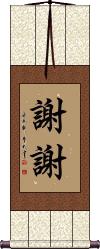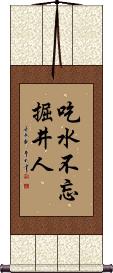Many custom options...
And formats...

Gratefulness in Chinese / Japanese...
Buy a Gratefulness calligraphy wall scroll here!
Personalize your custom “Gratefulness” project by clicking the button next to your favorite “Gratefulness” title below...
Respect
Politeness, Gratitude and Propriety
礼 is one of the five tenets of Confucius.
Beyond respect, 礼 can also be translated as propriety, good manners, politeness, rite, worship, or an expression of gratitude.
We show respect by speaking and acting with courtesy. We treat others with dignity and honor the rules of our family, school, and nation. Respect yourself, and others will respect you.
 Please note that Japanese use this simplified 礼 version of the original 禮 character for respect. 礼 also happens to be the same simplification used in mainland China. While 禮 is the traditional and original version, 礼 has been used as a shorthand version for many centuries. Click on the big 禮 character to the right if you want the Traditional Chinese and older Japanese versions.
Please note that Japanese use this simplified 礼 version of the original 禮 character for respect. 礼 also happens to be the same simplification used in mainland China. While 禮 is the traditional and original version, 礼 has been used as a shorthand version for many centuries. Click on the big 禮 character to the right if you want the Traditional Chinese and older Japanese versions.
This is also a virtue of the Samurai Warrior
See our page with just Code of the Samurai / Bushido here
See Also: Confucius
Gratitude / Thanks
感謝 is gratitude; the feeling of being grateful or thankful.
You can think of this as being a formal way of expressing thankfulness in Chinese, Japanese Kanji, and old Korean Hanja.
Thankfulness
感激 is thankfulness or being grateful for what you have.
It is an attitude of gratitude for learning, loving, and being. Appreciate the little things that happen around you and within you every day. Think positively. Thankfulness brings contentment.
Different meaning in Japanese - more like "deep emotion," "impression," "inspiration" - not recommended for a Japanese audience.
Thank You / Xie Xie
謝謝 is how to say thank you in Chinese. It is pronounced a bit like “shea shea” as in the English word for shea butter. Except you pronounce the X like “sh” but with your tongue firmly at the bottom of your mouth.
Unless you are putting this wall scroll near the exit of your store or restaurant to thank customers for coming, it is a bit of an odd selection. A gift of thanks to another person should be a more personal selection with more meaning than a simple thank you. Although common to write xie xie inside a card or letter of thanks.
Technically, this can be pronounced in Japanese but in Japan, it’s still the Chinese way to say thank you. It’s like an English speaker saying "gracias" (Spanish word for thank you).
Thank You / Arigato
Drinking the water of a well: One should never forget who dug it
This proverb suggests that one should always be grateful to those who helped one succeed.
And remember your ancestors and those that came before you whose sacrifices made your present life better.
Some Chinese will separate the intended meaning from this proverb and translate this as “Don't forget the people who once helped you.” In Modern China, this idiom is virtually never used to refer to an actual well.
Note: This can be pronounced in Korean but it's not a commonly used phrase.
These search terms might be related to Gratefulness:
Appreciation and Love for Your Parents
Appreciation of Truth by Meditation
Gratitude / Thanks
Thankfulness
Not the results for gratefulness that you were looking for?
Below are some entries from our dictionary that may match your gratefulness search...
| Characters If shown, 2nd row is Simp. Chinese |
Pronunciation Romanization |
Simple Dictionary Definition |
感恩 see styles |
gǎn ēn gan3 en1 kan en kanon かんおん |
to be grateful (n,vs,vi) gratitude; gratefulness; thanking; thanksgiving |
恩 see styles |
ēn en1 en on おん |
More info & calligraphy: Gracefavour; favor; obligation; debt of gratitude; (given name) Megumu Grace, favour. |
礼 see styles |
rei / re れい |
More info & calligraphy: Respect |
感激 see styles |
gǎn jī gan3 ji1 kan chi kangeki かんげき |
More info & calligraphy: Thankfulness(n,vs,vi) deep emotion; impression; inspiration |
感謝 感谢 see styles |
gǎn xiè gan3 xie4 kan hsieh kansha かんしゃ |
More info & calligraphy: Gratitude / Thanks(n,vs,vt,vi) thanks; gratitude; appreciation; thankfulness |
義理 义理 see styles |
yì lǐ yi4 li3 i li giri ぎり |
More info & calligraphy: Giri(noun - becomes adjective with の) (1) duty; sense of duty; honor; honour; decency; courtesy; debt of gratitude; social obligation; (can be adjective with の) (2) in-law; relation by marriage; (given name) Yoshimasa reason |
謝恩 谢恩 see styles |
xiè ēn xie4 en1 hsieh en shaon しゃおん |
More info & calligraphy: Shayne(n,vs,vi) (expression of) gratitude |
志 see styles |
zhì zhi4 chih kokorozashi こころざし |
aspiration; ambition; the will (1) will; resolution; intention; ambition; aim; goal; (2) kindness; goodwill; kind offer; (3) gift (as a token of gratitude); (female given name) Yuki Will, resolve, 志意; 心志; also data, records. |
紉 纫 see styles |
rèn ren4 jen |
to thread (a needle); to sew; to stitch; (literary) very grateful |
鳴 鸣 see styles |
míng ming2 ming mei / me めい |
to cry (of birds, animals and insects); to make a sound; to voice (one's gratitude, grievance etc) (female given name) Mei Cry, sound, note of a bird, etc.; Oh ! alas ! to wail. |
お礼 see styles |
orei / ore おれい |
(1) (polite language) thanks; gratitude; (2) (polite language) manners; etiquette; (3) (polite language) bow; (4) (polite language) reward; gift; (5) (polite language) ceremony; ritual |
会釈 see styles |
eshaku えしゃく |
(noun/participle) (1) slight bow (as a greeting or sign of gratitude); nod; salutation; (noun/participle) (2) consideration; thoughtfulness |
八種 八种 see styles |
bā zhǒng ba1 zhong3 pa chung yagusa やぐさ |
(place-name) Yagusa (布) 施 Eight causes of giving―convenience; fear; gratitude; reward-seeking; traditional (or customary); hoping for heaven; name and fame; personal virtue. |
労い see styles |
negirai ねぎらい |
appreciation; thanks; gratitude |
厚謝 see styles |
kousha / kosha こうしゃ |
(n,vs,vt,vi) deep gratitude |
報徳 see styles |
houtoku / hotoku ほうとく |
repayment of someone's kindness; showing one's gratitude; moral requital; (place-name) Houtoku |
報德 报德 see styles |
bào dé bao4 de2 pao te |
to repay debts of gratitude; to repay kindness |
報恩 报恩 see styles |
bào ēn bao4 en1 pao en houon / hoon ほうおん |
to pay a debt of gratitude; to repay a kindness (noun/participle) repaying a kindness; gratitude To acknowledge, or requite favours. |
大恩 see styles |
dà ēn da4 en1 ta en daion だいおん |
great debt of gratitude; great obligation great mercy |
幸甚 see styles |
xìng shèn xing4 shen4 hsing shen koujin / kojin こうじん |
(literary) very fortunate (form) (usu. in letters) being extremely grateful; being much obliged; being very appreciative; being very happy |
御礼 see styles |
onrei / onre おんれい orei / ore おれい |
(1) (polite language) thanks; gratitude; (2) (polite language) manners; etiquette; (3) (polite language) bow; (4) (polite language) reward; gift; (5) (polite language) ceremony; ritual |
微意 see styles |
bii / bi びい |
(humble language) small token (of gratitude); my (humble) feelings |
忝い see styles |
katajikenai かたじけない |
(adjective) (kana only) grateful; indebted |
忝涙 see styles |
katajikenamida かたじけなみだ |
tears of gratitude |
恐縮 see styles |
kyoushuku / kyoshuku きょうしゅく |
(n,vs,vi) (1) feeling (much) obliged; being (very) grateful; being thankful; (n,vs,vi) (2) (oft. before a request, as 恐縮ですが) feeling sorry (for troubling someone); feeling ashamed (e.g. of an error); feeling embarrassed (e.g. by someone's compliments, hospitality, etc.); (n,vs,vi) (3) (archaism) shrinking back in fear |
恩仇 see styles |
ēn chóu en1 chou2 en ch`ou en chou |
debt of gratitude coupled with duty to avenge |
恩師 恩师 see styles |
ēn shī en1 shi1 en shih onshi おんし |
(greatly respected) teacher (honorific or respectful language) teacher (to whom one owes a debt of gratitude); mentor; one's former teacher beneficent master |
恩怨 see styles |
ēn yuàn en1 yuan4 en yüan |
gratitude and grudges; resentment; grudges; grievances |
恩田 see styles |
ēn tián en1 tian2 en t`ien en tien onda おんだ |
(place-name, surname) Onda The field of grace, i.e. parents, teachers, elders, monks, in return for the benefits they have conferred; one of the 三福田. |
恩義 恩义 see styles |
ēn yì en1 yi4 en i ongi おんぎ |
feelings of gratitude and loyalty obligation; favour; favor; debt of gratitude |
Click here for more gratefulness results from our dictionary
The following table may be helpful for those studying Chinese or Japanese...
| Title | Characters | Romaji (Romanized Japanese) | Various forms of Romanized Chinese | |
| Respect | 禮 礼 | rei | lǐ / li3 / li | |
| Gratitude Thanks | 感謝 | kan sha / kansha | gǎn xiè / gan3 xie4 / gan xie / ganxie | kan hsieh / kanhsieh |
| Thankfulness | 感激 | kangeki | gǎn jī / gan3 ji1 / gan ji / ganji | kan chi / kanchi |
| Thank You Xie Xie | 謝謝 / 謝々 谢谢 | shie shie / shieshie | xiè xie / xie4 xie / xie xie / xiexie | hsieh hsieh / hsiehhsieh |
| Thank You Arigato | ありがとう | arigato | ||
| Drinking the water of a well: One should never forget who dug it | 吃水不忘掘井人 | chī shuǐ bú wàng jué jǐng rén chi1 shui3 bu2 wang4 jue2 jing3 ren2 chi shui bu wang jue jing ren chishuibuwangjuejingren | ch`ih shui pu wang chüeh ching jen chih shui pu wang chüeh ching jen |
|
| In some entries above you will see that characters have different versions above and below a line. In these cases, the characters above the line are Traditional Chinese, while the ones below are Simplified Chinese. | ||||
Successful Chinese Character and Japanese Kanji calligraphy searches within the last few hours...









